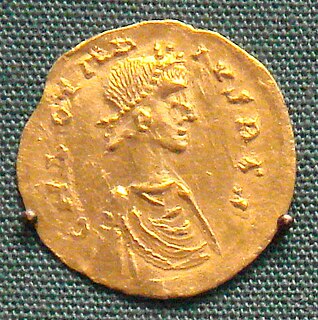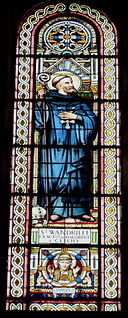Related Research Articles

Pepin Iof Landen, also called the Elder or the Old, was the Mayor of the Palace of Austrasia under the Merovingian king Dagobert I from 623 to 629. He was also the mayor for Sigebert III from 639 until his death.

Austrasia, was a territory which formed the northeastern section of the Merovingian Kingdom of the Franks during the 6th to 8th centuries. It was centred on the Meuse, Middle Rhine and the Moselle rivers, and was the original territory of the Franks, including both the so-called Salians and Rhineland Franks, which Clovis I conquered after first taking control of the bordering part of Roman Gaul, now northern France, which is sometimes described in this period as Neustria.

Chlothar II, called the Great or the Young, was king of Neustria and king of the Franks, and the son of Chilperic I and his third wife, Fredegund. He started his reign as an infant under the regency of his mother, who was in an uneasy alliance with Clothar's uncle King Guntram of Burgundy. Clothar assumed full power over Neustria upon the death of his mother, in 597; though rich this was one of the smallest portions of Francia. He continued his mother's feud with Queen Brunhilda of Austrasia with equal viciousness and bloodshed, finally achieving her execution in an especially brutal manner in 613, after winning the battle that enabled Chlothar to unite Francia under his rule. Like his father, he built up his territories by moving in after the deaths of other kings.

Neustria, was the western part of the Kingdom of the Franks.

Saint Arnulf of Metz was a Frankish bishop of Metz and advisor to the Merovingian court of Austrasia, who retired to the Abbey of Remiremont. In French he is also known as Arnoul or Arnoulf. In English he is known as Arnold.

Amandus, commonly called Saint Amand, was a bishop of Tongeren-Maastricht and one of the great Christian missionaries of Flanders. He is venerated as a saint, particularly in France and Belgium.

Sigebert III was the Merovingian king of Austrasia from 633 to his death around 656. He was described as the first Merovingian roi fainéant —do-nothing king—, in effect the mayor of the palace ruling the kingdom throughout his reign. However he lived a pious Christian life and was later sanctified, being remembered as Saint Sigebert of Austrasia in the Roman Catholic Church and Eastern Orthodox Church.

Saint Hermenegild or Ermengild, was the son of king Liuvigild of the Visigothic Kingdom in the Iberian Peninsula and southern France. He fell out with his father in 579, then revolted the following year. During his rebellion, he converted from Arianism to Chalcedonian Christianity. Hermenegild was defeated in 584 and exiled. His death was later celebrated as a martyrdom due to the influence of Pope Gregory I's Dialogues, in which he portrayed Hermenegild as a "Catholic martyr rebelling against the tyranny of an Arian father."

Audoin was a Frankish bishop, courtier, chronicler, and Catholic saint. Audoin was both Lord Chancellor of France and Référendaire of France.
Grimoald I (616–657), called the Elder, was the Mayor of the Palace of Austrasia from 640 to 656. He was the son of Pepin of Landen and Itta.
Erchinoald succeeded Aega as the mayor of the palace of Neustria in 641 and succeeded Flaochad in Burgundy in 642 and remained such until his death in 658.

Fontenelle Abbey or the Abbey of St Wandrille is a Benedictine monastery in the commune of Saint-Wandrille-Rançon. It was founded in 649 near Caudebec-en-Caux in Seine-Maritime, Normandy, France.
Itta of Metz, O.S.B. was the wife of Pepin of Landen, Mayor of the Palace of the Kingdom of Austrasia. After his death, she founded the Abbey of Nivelles, where she became a Colombanian nun along with her daughter, Gertrude of Nivelles. Both are honored as saints by the Catholic Church.
Saint Beuve and her brother Balderic lived in the 7th century in France. According to Christian Settipani, their father was probably Sigobert the Lame, King of Cologne, rather than Sigebert I of Austrasia, as indicated by Flodoard. Together they founded the Abbey of Saint Pierre de Reims. Beuve was the first abbess.
Saint Dode was an Abbess of Saint Pierre de Reims and a French Saint whose Feast Day is 24 April. She is reputed to be the daughter of Chloderic, King of the Ripuarian Franks and the sister of Munderic, making her a princess of the Ripuarian Franks.
Ferreolus, also called Ferreolus of Rodez was a Gallo-Roman senator from Narbonne, then Narbo, who later lived in Rodez where his family had also held Trevidos, a villa estate near Segodunum, since the mid-fifth century at least.
Saint Romaric was a Frankish nobleman who lived in Austrasia from the late 6th century until the middle of the 7th century. He and Amatus of Grenoble founded Remiremont Abbey.

Saint Wandregisel was a Frankish courtier, monk, and abbot.
Saint Bonitus (623–710) was born in France and held a number of important positions including being appointed governor of Marseilles in 667 and Bishop of Auvergne. He was also chancellor and referendary in Francia.
Adalbert I of Ostrevent, was a 7th-century Frankish nobleman of the Court of King Clovis II of France. He is recognized as a saint, and is commemorated both on 2 February and 2 May.
References
- ↑ Monks of Ramsgate. “Balderic”. Book of Saints, 1921. CatholicSaints.Info. 18 August 2012
- ↑ Rabenstein, Katherine (1998). "Reineldis VM (RM)". Saints of the Day for October 16. Retrieved 2008-01-03.
- Butler, Alban. "Wandregisel", Lives of the Saints, edited by Thurston and Attwater.
- Butler, Alban. Lives of the Fathers, Martyrs and Other Principal Saints. J. Duffy, 1866.
- Catholic Encyclopedia, 1913.
This article needs additional or more specific categories .(December 2019) |